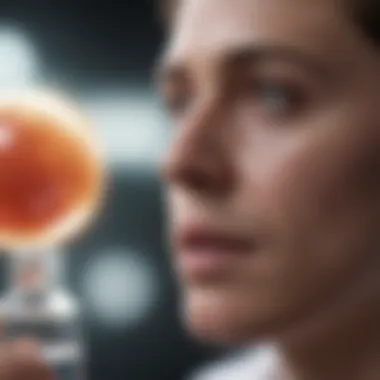Exploring Innovative Treatments for Polycythemia Vera


Intro
Polycythemia Vera (PV) represents a complex hematological condition characterized by an overproduction of red blood cells. Understanding its potential cures is essential not only for healthcare professionals but also for patients navigating their treatment options. This article aims to dissect the multifaceted approaches toward PV management, balancing established therapies with novel treatments that are currently under investigation.
The pathophysiology of PV is critical; it often revolves around the mutation of the JAK2 gene. This mutation leads to dysregulation of erythropoiesis, resulting in increased blood viscosity and other complications. Therefore, grasping the intricacies of PV paves the way for more effective treatment strategies. In this guide, readers will find a thorough examination of current research trends and insights into ongoing clinical trials, highlighting the relevance of these findings for future patient outcomes.
The implications of emerging treatments could reshape paradigms in PV management, thus sustaining research efforts to enhance quality of life for affected individuals. This discussion is crucial for a diverse audience, including students, researchers, educators, and professionals dedicated to understanding or conducting research in this domain.
Research Overview
Key Findings
Research into Polycythemia Vera reveals significant advances in both understanding the disease and developing therapeutic interventions. Studies indicate that the presence of the JAK2 V617F mutation is prevalent among patients. As a result, therapies targeting this mutation have gained prominence. Here are some key findings:
- Targeted Therapies: Newer drugs, such as ruxolitinib, have shown promise in efficacy, reducing red cell mass and improving patient outcomes.
- Clinical Trials: Numerous trials are investigating alternative JAK2 inhibitors and novel therapeutic approaches such as immunotherapy and gene editing.
- Epidemiological Trends: Research highlights variations in PV prevalence, suggesting environmental factors may play a role in disease manifestation.
Study Methodology
To gain insights into the potential cures for PV, researchers employ various methodologies. Most studies use population-based data, clinical trials, and laboratory experiments. Key methodologies include:
- Longitudinal Studies: Observing patient outcomes over extended periods offers valuable information regarding disease progression and treatment efficacy.
- Randomized Controlled Trials: These trials are crucial for assessing the effectiveness of new medications compared to current standards of care.
- Genetic Analysis: Understanding the genetic basis of PV aids in developing targeted therapies, emphasizing the need for individualized treatment strategies.
Background and Context
Historical Background
The recognition of Polycythemia Vera as a distinct clinical entity dates back to the early 20th century. Initially described by Karl Landsteiner and subsequently researched extensively, the disease has undergone various classification changes as our understanding improved. The identification of the JAK2 mutation in 2005 marked a pivotal moment, providing a clearer genetic understanding of the disease's etiology.
Current Trends in the Field
Recent trends in Polycythemia Vera research indicate a shift towards more personalized medicine and targeted therapies. The development of JAK inhibitors represents a significant advancement in treatment. Ongoing research is also highlighting the role of supplemental therapies, such as phlebotomy and low-dose aspirin, in symptom management. Moreover, clinical collaborations are increasing in number, reflecting a collective effort to enhance research quality and share findings.
"The evolution of treatment strategies in Polycythemia Vera underscores the importance of continual research and adaptation to emerging scientific knowledge."
These advancements collectively pave the way for improved patient management and better understanding of the disease's complexities. A thorough overview of this topic illustrates its critical relevance to both current practice and future therapies.
Foreword to Polycythemia Vera
Understanding Polycythemia Vera (PV) is crucial due to its implications for patient health and the evolving landscape of treatment options. This section aims to frame PV not just as a medical condition but as an area of active research that impacts the lives of those affected. By grasping its definition, prevalence, and the underlying mechanisms, we can appreciate the foundation upon which current and potential treatments are developed. This knowledge is vital for students, researchers, educators, and professionals invested in the field.
Definition and Overview
Polycythemia Vera is a type of blood cancer categorized under myeloproliferative neoplasms. This rare disorder leads to the overproduction of red blood cells, which can cause increased blood viscosity. Symptoms often include headaches, dizziness, and visual disturbances, owing to the elevated blood counts that result from the disease. Alternatively, some patients may remain asymptomatic for extended periods. This variability in clinical presentation makes the disease unique and challenging to diagnose.


Epidemiology of Polycythemia Vera
The epidemiology of Polycythemia Vera reveals interesting statistics. The incidence rate is approximately 2 cases per 100,000 individuals annually. The condition typically manifests in adults, predominantly those aged 60 and over. It is slightly more prevalent in men than in women. Geographic distribution indicates a higher prevalence in certain populations, particularly individuals of Eastern European Jewish descent. Understanding these demographics can help focus research and treatment efforts more effectively.
Pathophysiology of the Disease
The pathophysiology of PV is centered around genetic mutations, particularly in the JAK2 gene. This mutation leads to unchecked cell proliferation, causing an overproduction of not only red blood cells but also platelets and white blood cells. The resulting hyperviscosity can severely impact circulation and oxygen delivery. The molecular changes are essential to understanding both the disease progression and the rationale behind targeted treatment strategies.
Polycythemia Vera presents a complex interplay of genetic, environmental, and hematological factors, making it a focal point for research into novel therapeutic approaches.
Current Treatment Modalities
Current treatment modalities for Polycythemia Vera (PV) are vital to manage this complex disorder effectively. Understanding these modalities helps both healthcare professionals and patients navigate through the implications of treatment choices. The key aspect of managing PV is to reduce the risks related to high red blood cell counts. A multidisciplinary approach combines therapies that address symptoms, improve quality of life, and target the underlying disease mechanisms.
Phlebotomy as a Standard Treatment
Phlebotomy is one of the most established treatments for Polycythemia Vera. This procedure involves the removal of blood from the body to decrease red blood cell mass and, consequently, blood viscosity. It is typically performed on a regular basis depending on the patient’s hematocrit level.
This method not only reduces the risks of thrombosis but also effectively lowers blood pressure and can alleviate symptoms like headaches and dizziness. Patients often find the process manageable, and it has a strong safety profile. However, over time, frequent phlebotomies can lead to iron deficiency, warranting careful monitoring of iron levels in patients.
Medications: Hydroxyurea and Interferon
Alongside phlebotomy, medications play a critical role in treating Polycythemia Vera. Two frequently used drugs are Hydroxyurea and Interferon. Hydroxyurea is an oral medication that works by inhibiting the proliferation of abnormal blood cells. It is useful for patients with higher hematocrit levels and those who have not responded well to phlebotomy alone.
Interferon, another option, is a biologic drug that helps regulate the immune system. While it is less commonly prescribed due to its side effects, it has shown promise in inducing remission in some patients. Both medications have a nuanced mechanism of action, aiming to bring down elevated blood cell counts while minimizing the risk of complications. It is essential to individualize treatment based on patient characteristics and response to therapy.
Targeted Therapies: JAK Inhibitors
JAK inhibitors represent a significant advancement in the treatment of Polycythemia Vera. Ruxolitinib is a notable example of this class. These medications specifically target and inhibit the Janus kinase pathways that play a role in cell signaling within the hematopoietic (blood-forming) system. By blocking these signals, JAK inhibitors effectively reduce blood cell production in patients.
This approach offers a modern strategy for patients who have failed other treatments or have advanced forms of the disease. Moreover, JAK inhibitors not only work to lower hematocrit levels but also address disease-related symptoms such as splenomegaly (enlarged spleen). Nonetheless, ongoing monitoring is necessary due to potential adverse effects, including the risk of infections and other complications associated with immunosuppression.
Investigation of Novel Cures
The exploration of novel cures for Polycythemia Vera (PV) is crucial in advancing treatment options and improving patient outcomes. Given that PV can lead to serious complications like thrombosis, an innovative approach is urgently needed. Research into new therapies not only provides hope for patients but also emphasizes the dynamic nature of cancer treatment. Novel remedies may promise better efficacy, fewer side effects, and even curative potentials that existing treatments lack.
A clear understanding of the challenges and opportunities in this field can frame the future of PV management. With continuous advancements, the investigation into potential cures can pave the way for more personalized, effective treatment strategies.
Emerging Therapies in Clinical Trials
Research is ongoing to uncover new therapies that may offer significant benefits over traditional treatments. Clinical trials serve as a platform to test these emerging therapies. They often include agents like newer anti-cancer drugs, which can target specific pathways involved in PV. Evaluating these therapies involves understanding their mechanism, dosing, and potential outcomes.
One promising area is the investigation of agents that can inhibit the JAK2 V617F mutation, which is found in the majority of PV cases. These trials are essential as they provide real-time data on efficacy and safety before these treatments can gain wider acceptance.
Gene Therapy Approaches


Gene therapy is an area of great interest in the treatment of PV. It has the potential to correct the underlying genetic mutations that lead to the disease. By delivering therapeutic genes to target cells, it may be possible to induce a response that normalizes blood cell production.
While still largely experimental, the advent of CRISPR technology has opened doors to modify genes with high precision. This technology fosters hope that a cure could be achievable by directly addressing the genetic basis of PV.
Innovations in Cell Therapy
Cell therapy represents another frontier in evolving treatments for PV. This method can involve the use of stem cells or modified immune cells to restore normal blood cell production. For instance, researchers are exploring the possibilities of hematopoietic stem cell transplantation for eligible patients, providing a potential cure in cases where standard therapies fall short.
Innovations in cell therapy could lead to a more definitive management of PV than current options. Efforts are ongoing to assess the safety and efficacy of these methods, ensuring that any new approaches carry minimal risks.
The journey towards finding potential cures for Polycythemia Vera highlights a commitment to not just control but to curative strategies for affecting patient care significantly.
Challenges in Treatment
The topic of challenges in treatment is essential when discussing Polycythemia Vera (PV). This section aims to highlight the complexities faced by healthcare professionals and patients alike. Understanding these challenges will provide insights into why improving treatment strategies is crucial. The implications of ineffective treatments can significantly impact patient outcomes and quality of life.
Resistance to Existing Therapies
One of the prominent concerns in treating Polycythemia Vera is the resistance that some patients develop to existing therapies. This resistance can manifest in various ways, leading to suboptimal outcomes. Not all patients respond uniformly to treatment. For example, while hydroxyurea and JAK inhibitors like Ruxolitinib are effective for many, a subset of patients either sees limited benefits or faces severe side effects.
"Therapeutic resistance not only complicates treatment plans but also requires continuous monitoring and adaptation of therapy."
This resistance can stem from several factors:
- Genetic Variation: Individual genetic differences can influence how effectively a drug acts within the body. Certain mutations may make targeted treatments less effective.
- Polypharmacy: Patients often take multiple medications for different conditions, leading to potential drug interactions that can diminish the therapeutic effects.
- Treatment Adherence: Non-adherence to treatment regimens can exacerbate resistance. Patients may struggle with side effects or misinterpret the importance of regular medication.
These resistances require ongoing research to understand better and address this challenge through novel therapies or combination treatment approaches.
Managing Patient Quality of Life
Quality of life is a critical consideration in the treatment of Polycythemia Vera. Patients often experience symptoms that may not only stem from the disease itself but also from the side effects of treatments. Fatigue, headaches, and dizziness are commonly reported issues that affect daily living.
Healthcare providers must focus on enhancing quality of life, which can involve:
- Symptom Management: Actively managing symptoms is vital. This can include the use of analgesics for headaches or strategies to alleviate fatigue.
- Psychosocial Support: Psychological well-being is often overlooked. Counseling or support groups can provide emotional relief and help patients cope with their diagnosis.
- Lifestyle Adjustments: Nutrition and exercise play essential roles. Encouraging a balanced diet and physical activity can help mitigate some symptoms and improve overall health.
Regular follow-ups can help adjust treatment plans to better suit individual needs, ensuring that the focus remains on both efficacy and quality of life.
Adverse Effects of Treatments
The side effects from treatments pose another layer of complexity in managing Polycythemia Vera. While therapies aim to reduce elevated red blood cell levels, they can result in adverse effects that necessitate careful monitoring. Common side effects associated with treatments include:
- Bone Marrow Suppression: Medications like hydroxyurea can affect bone marrow function, leading to anemia and increased susceptibility to infections.
- Gastrointestinal Issues: Some treatments lead to nausea, vomiting, or diarrhea, making it challenging for patients to maintain proper nutrition.
- Dermatological Reactions: Skin reactions can occur, particularly with newer medications, potentially affecting patient compliance.


Raising patient awareness about these side effects is crucial. They should be encouraged to promptly report issues, allowing healthcare providers to make necessary adjustments in treatment routes. Ultimately, better communication between clinicians and patients contributes to enhanced care management.
Each of these challenges in treatment underscores the complexity surrounding Polycythemia Vera. Addressing resistance, enhancing patient quality of life, and managing side effects are fundamental to optimizing treatment outcomes.
Future Directions in PV Research
Future directions in polycythemia vera (PV) research are critical for advancing the understanding and treatment of this complex disorder. This section explores three pivotal areas of exploration: integrating multi-omics approaches, the role of personalized medicine, and identifying relevant biomarkers in therapy selection. These elements are not only essential for improving patient outcomes but also for fostering innovation in treatment strategies. Understanding these future directions can provide insight into how therapies may evolve, thereby improving quality of life for individuals affected by PV.
Integrating Multi-Omics Approaches
The integration of multi-omics approaches includes genomics, proteomics, metabolomics, and transcriptomics, forming a comprehensive picture of the biological processes underlying PV. This holistic view allows researchers to identify molecular pathways that contribute to disease progression and response to treatment. By combining data from these different layers, scientists can uncover intricate relationships that single-omics studies might overlook.
In practice, applying multi-omics can help in:
- Identifying potential drug targets.
- Understanding the heterogeneity of PV.
- Developing more effective treatment regimens.
This deeper understanding could lead to breakthroughs in how PV is managed, leading to tailored therapies that address the unique profile of each patient. Moreover, it paves the way for innovative clinical trials that can test new treatment options based on the genomic and proteomic landscape of PV patients.
Personalized Medicine for PV
Personalized medicine represents a transformative shift in treating PV, focusing on tailoring therapy based on individual characteristics. This approach considers genetic, environmental, and lifestyle factors that influence patient responses to treatment. Personalized strategies can optimize existing therapies, reduce adverse effects, and increase the likelihood of positive outcomes.
Benefits of personalized medicine in PV include:
- Enhanced effectiveness of treatments through targeted therapies.
- Reduced trial and error in prescribing medications.
- More informed discussions between healthcare providers and patients regarding treatment options.
The ongoing research in this sphere is essential for moving towards a more individualized approach, ensuring that patients receive the most suitable intervention for their specific conditions.
Role of Biomarkers in Therapy Selection
Biomarkers play a vital role in the diagnosis, prognosis, and treatment response of PV. They serve as indicators of disease status, treatment efficacy, and even potential treatment-resistant cases. The identification and validation of specific biomarkers could significantly enhance therapy selection processes.
Key aspects related to biomarkers include:
- Identification of molecular signatures specific to PV.
- Evaluation of treatment responses based on biomarker levels.
- Improved stratification of patients into risk categories, allowing for more targeted interventions.
Using biomarkers could aid clinicians in making evidence-based decisions, potentially revolutionizing how PV is treated. As research in this area progresses, it may lead to standardized protocols for therapy selection that are guided by reliable biomarker assessments.
"The future of treating polycythemia vera may very well hinge on our ability to apply multi-omics strategies, personalize treatments, and effectively utilize biomarkers to better our understanding and approach to this challenging disease."
Culmination
The conclusion of this article emphasizes the intricate landscape surrounding potential cures for Polycythemia Vera (PV). It is vital to recognize the ongoing developments in treatment methodologies and the necessity of tailored approaches to patient care. This segment serves as a synthesis of the insights and findings discussed throughout the article, aiding in understanding the complexities of PV.
Summary of Key Insights
The discussion has highlighted numerous facets of PV and its treatment options. Established therapies, including phlebotomy and medication, remain essential in managing the condition. Emerging therapies and innovative research provide hope for future advancements. A significant point made is the need for an integrative perspective on treatment, balancing established and novel methodologies. Attention to the individual's unique pathophysiology is crucial for optimized outcomes.
Implications for Future Research
There are profound implications for future research pathways in the field of Polycythemia Vera. Researchers are encouraged to focus on multi-omics approaches that encompass genetic, proteomic, and metabolomic data. This comprehensive perspective can significantly contribute to personalized medicine strategies, tailoring treatments according to individual patient profiles. Emphasis must also be placed on the continuous monitoring of biomarkers, which can elucidate treatment responses and guide therapy selection effectively.







